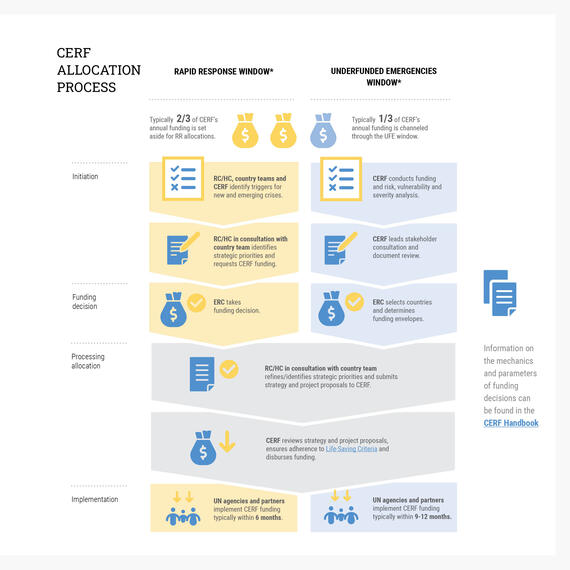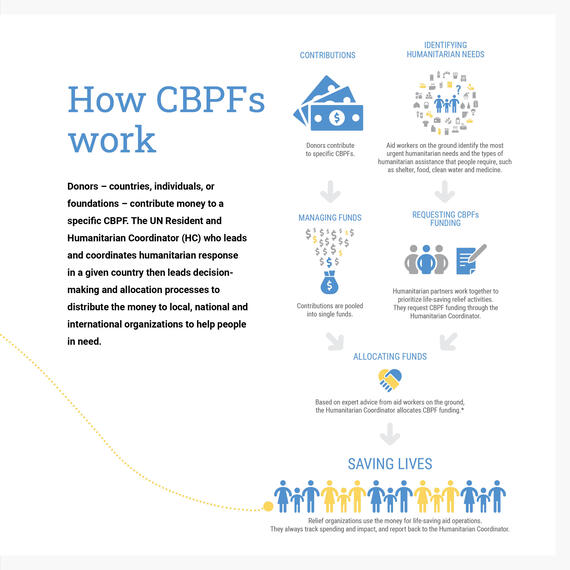
Letter from the Emergency Relief Coordinator 2023 was an undeniably arduous year marked by unremitting global challenges. From Ukraine and Sudan, to the Occupied Palestinian Territory (OPT), the...

We work with humanitarian partners around the world to identify the most critical humanitarian needs, plan responses and determine the budgets needed to address them.
We help drive humanitarian action by encouraging new, more effective funding and financing mechanisms that respond to and reflect the changing nature of humanitarian crises.
At the country level, we work with partners to build common strategies and implementation plans for joint funding appeals. This ensures collective resource mobilization and financing based on a common needs evaluation, making aid more effective, efficient and predictable. At a global level, this work culminates in the annual Global Humanitarian Overview.
Our financial-tracking tools and services – including the Financial Tracking Service (FTS) – help manage humanitarian funding. FTS provides information to support our advocacy, policymaking and humanitarian financing work. It also helps improve strategic and operational decision-making by enabling effective field coordination.
We also ensure more responsive, predictable and strategic humanitarian financing through OCHA’s leadership of the Central Emergency Response Fund (CERF) and Country-Based Pooled Funds (CBPFs).
OCHA-managed pooled funds are effective ways to support humanitarian action. They allow Governments and private donors to pool their contributions into common, unearmarked funds to deliver life-saving assistance to people who need it most. There are two types of pooled funds: CERF, which can fund an emergency anywhere in the world, and the CBPFs, which are country specific.
These funds represent a relatively small portion of global humanitarian funding, but they are critical to the delivery of life-saving assistance. They strengthen the collective humanitarian response, empower leadership and improve coordination
CERF and CBPF allocations are designed to complement other humanitarian funding sources, such as bilateral funding. They can be used independently, but they also work in synergy with other funding streams. You can read more about the value and impact the humanitarian pooled funds at the Pooled Funds Story Hub.
Central Emergency Response Fund (CERF) enables humanitarian organizations to kick-start urgent aid operations worldwide within just hours of a sudden-onset emergency, and to reach crisis-affected people who are not receiving the attention and funding they need.
It can also scale up and expand assistance when a situation deteriorates suddenly, and it sustains critical assistance in crises that fail to attract sufficient resources.
CERF receives contributions year-round from donors – mainly Governments but also foundations, companies, charities and individuals – into a single global fund.
CERF allocations are available to UN agencies, funds and programmes, and they are informed by joint needs assessments, expert advice from aid workers and priorities set out in country-level plans. CERF has a US$1 billion annual funding target and is fully unearmarked to ensure funds meet the most urgent, life-saving needs.

In a humanitarian crisis, organizations on the ground assess and prioritize needs together. UN funds, programmes and specialized agencies are eligible for CERF funding. They work with local, national and international non-governmental organizations (NGOs), host governments and Red Cross/Red Crescent Societies to implement grants. Resident and Humanitarian Coordinators can apply for CERF funding when the country’s needs exceed UN organizations’ capacity to respond.
CERF is guided by the humanitarian principles of humanity, neutrality and impartiality. It provides funding based on needs, risks and collective priorities. Humanitarian partners work together to identify and prioritize activities for a CERF request, based on evidence, assessments of need and, in sudden-onset disasters, projections and forecasts. Then the Resident and Humanitarian Coordinator (RC/HC) and UN Country Team/ Humanitarian Country Team develop applications for the funding based on these priorities. They are guided by CERF’s Life-Saving Criteria. The RC/HC submits a prioritized proposal to the CERF secretariat, which reviews it and supports the Emergency Relief Coordinator in deciding on the allocation of funding to partners on the ground.
Visit the CERF website
Visit the CERF Data Hub
Country-Based Pooled Funds (CBPFs) are established when an emergency occurs or when an existing crisis deteriorates. They are managed by OCHA under the leadership of the Humanitarian Coordinators (HCs) or UN Resident Coordinators (RCs) and in close consultation with the humanitarian community.
Contributions are collected into single, unearmarked funds. These funds support high-priority projects being undertaken by those best placed to respond (including international and national NGOs and UN agencies) through an inclusive and transparent process that supports priorities set out in Humanitarian Response Plans. This ensures funding is available and prioritized locally by those closest to people in need.

Donors – countries, individuals, or foundations – contribute money to a specific CBPF. The RC/HC in each country leads the decision-making and allocation processes to distribute the money to local, national and international organizations to help people in need.
A localized response is a critical objective of the funds. Local non-governmental organizations and aid workers are often the backbone of humanitarian response. They bring unique networks, approaches and skills, including language which helps them identify the people most in need. CBPFs’ country presence and broad partnership networks enables them to strengthen local and national actors’ engagement in humanitarian responses.
The funds are managed by OCHA at the country level under the UN humanitarian leadership. They empower humanitarian leadership and promote coordination among humanitarian actors. Advisory Boards support the management of the CBPFs by making key decisions.
Read more about Country-Based Pooled Funds
Visit the Pooled Funds Data Hub
World + 18 more
Evaluation and Lessons Learned
Letter from the Emergency Relief Coordinator 2023 was an undeniably arduous year marked by unremitting global challenges. From Ukraine and Sudan, to the Occupied Palestinian Territory (OPT), the...
World
Other
Letter from the Emergency Relief Coordinator We thought 2022 was an unforgiving year for people caught up in crises. 2023 turned out to be even worse. From the Occupied Palestinian Territory to...
World
Manual and Guideline
Introduction 1.1. Purpose and scope of the Global Guidelines The purpose of these Global Guidelines is to ensure a coherent and harmonised approach to the governance and operations of Country-based...
World
Manual and Guideline
Using the CERF Handbook The Handbook is a reference tool to find quick answers on the Central Emergency Response Fund (CERF) as well as a guide to applying for and maximizing the impact of CERF...